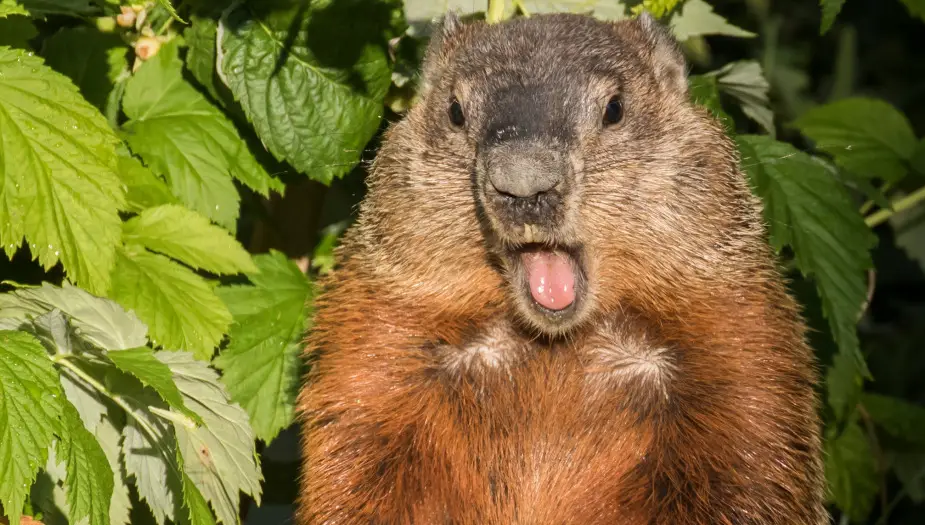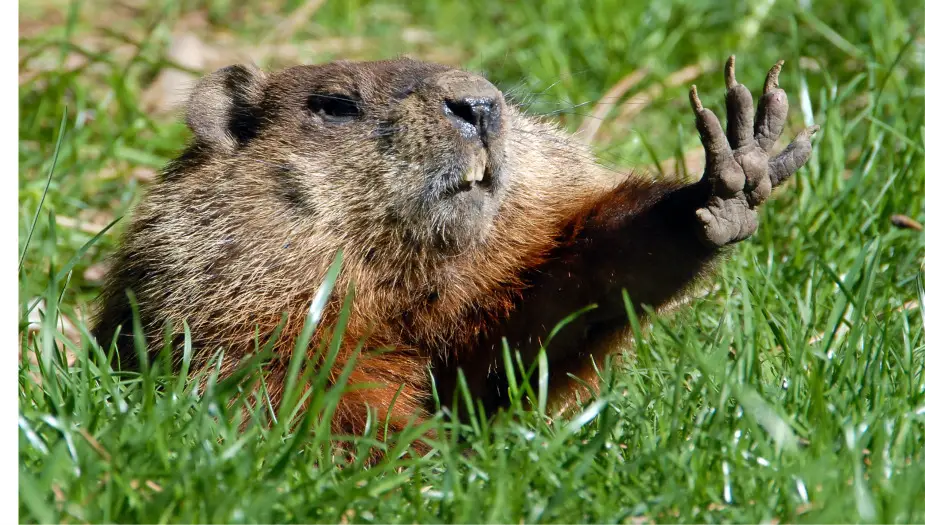What is the difference between a Gopher and a Groundhog?
The main difference between a gopher and a groundhog is size. Gophers are much smaller, measuring about 5-14 inches long, while groundhogs can be up to 2 feet in length.

Gopher vs Groundhog Appearance and Size
The difference between a Gopher and Groundhogs appearance is quite significant. Groundhogs are much larger than Gophers and can reach up to 26 inches in length and weigh between 4-10 pounds.
They have a brownish-gray fur covering their body, short ears and a short tail. Gophers, on the other hand, are much smaller ranging in size from 6-14 inches long and weighing 2-4 pounds.
They have thick fur that is generally reddish-brown, small ears and no visible tail.
Groundhogs also have specially adapted front claws which they use to dig deep burrows while Gophers have smaller teeth and smaller feet making them more adept at tunneling through the ground.
Groundhogs are also much more active during the day while Gophers are nocturnal, coming out mostly at night. They both hibernate during the winter months and store food for this time period.
Gopher vs Groundhog Families
Gophers and Groundhogs are members of two different scientific families. Gophers belong to the Geomyidae family while Groundhogs belong to the Marmota monax family.
Both species are considered rodents as they both have front teeth that continuously grow throughout their life due to constant gnawing.
Groundhog vs Gopher Food & Diet

The difference between Gopher and Groundhogs diets is quite clear. Gophers are strict herbivores, meaning they feed on plants and vegetables like roots, grasses, and leaves.
Groundhogs, on the other hand, are omnivores, meaning they will eat both plants and small animals including insects, frogs, lizards and even birds’ eggs.
They will also eat fruits and berries when available.
Groundhogs will feed mostly on plants during the spring and summer, while Gophers feed on plants throughout the year.
During autumn Ground hogs will store food for winter hibernation and Gophers do not do this as their underground burrows act as natural storage areas. Gophers also have a more diverse diet than groundhogs as they will also eat some soil and small stones to help with digestion.
Groundhog vs Gopher Holes
Groundhogs and Gophers both dig burrows or holes in the ground. Groundhog burrows are larger and deeper than Gopher tunnels, with some being 6 feet deep.
Ground hogs typically make their homes near open fields, meadows, forests and yards. Gopher tunnels, on the other hand, are much shallower but more extensive with one single Gopher creating up to 200 yards of burrow.
Gophers tend to make their homes in orchards and gardens where they can find plenty of vegetation.
Gopher vs Groundhog Habits
The difference between Groundhog and Gopher habits is quite distinct.
Groundhogs are mostly solitary animals, coming together during the mating season and hibernation period. Gophers, however, live in colonies with each Gopher having its own specific tunnel system.
Groundhogs will also make an effort to protect their burrows while Gophers do not because they have multiple exits.
Gopher vs Groundhog Predators
Gophers and Groundhogs have many different predators depending on the location.
Common Gopher predators include foxes, coyotes, badgers, weasels, hawks, owls, snakes and cats. Groundhog predators include foxes, bobcats, bears and wolves.
Both species can become prey to other animals if their burrows are discovered. Gophers are also more likely to become food for snakes who can enter their tunnels more easily.
Groundhog vs Gopher Weight & Lifespan
Groundhogs can weigh up to 20 pounds while Gophers generally only weigh a few pounds. Groundhogs have an average lifespan of 3-6 years while Gophers can live up to 8 years.
Gopher vs Groundhog Adaptations

Groundhogs and Gophers have both evolved different adaptations to help them survive. Groundhogs have adapted their front claws which helps them dig tunnels and make their burrows. They also have thick fur which helps keep them warm during hibernation.
Gophers, on the other hand, have adapted their teeth which help them chew through vegetation and dig tunnels. They also have fur-lined cheek pouches which enable them to carry food more easily.
Gopher vs Groundhog Damage
Gophers and Groundhogs can both cause significant damage to crops, gardens, and lawns. Gophers tend to feed on vegetation more than Groundhogs which can leave large patches devoid of plants.
Groundhogs, however, are more likely to cause structural damage as they dig deeper burrows. Both species can also cause damage to underground pipes and cables by digging around them or even blocking them completely.
Gopher vs Groundhog vs Beaver
Beavers are a bit different than both gophers and Groundhogs. Beavers are semi-aquatic and spend their time in the water, building dams to create ponds and wetlands.
Beavers also have large incisors which they use to gnaw through trees, while Gophers and Groundhogs do not. Beavers can also be much larger than both Gophers and Groundhogs, weighing up to 65 pounds.
Gopher vs Groundhog vs Woodchuck
Woodchucks, also known as Groundhogs, are similar to Gophers in size and weight. However, they have some different adaptations that make them unique.
Woodchucks have a thick coat of fur which helps keep them warm during the colder months and flat claws which help them climb trees.
They also have different diets than Gophers, with woodchucks being omnivores while Gophers are mainly herbivorous.
Gopher vs Groundhog vs Prairie Dog
Prairie Dogs are similar to Gophers in many ways, but they also have some unique characteristics. Prairie Dogs live in colonies and are highly social animals, while Gophers are primarily solitary.
Prairie Dogs also have bigger eyes and ears than Gophers and they can climb trees, which Gophers cannot.
Prairie Dogs can weigh up to 3 pounds while Gophers generally do not exceed a few ounces.
Gopher and Groundhog Control Methods

The best way to control Gophers and Groundhogs is to first properly identify them. Once you know what species you are dealing with, then you can choose the most appropriate control method.
Common methods used for both species include traps, fumigants and repellents. Trapping should be done carefully as it can disrupt populations of either species. Fumigants can be effective in controlling both
Gophers and Groundhogs, however they must be applied correctly to ensure their efficacy. Repellents are also available, although they may not always be as effective as other methods. Professional assistance is recommended if you are unsure of how to control either species.
For more information about controlling gophers and Groundhogs, consult your local extension office or wildlife management agency. Your local experts can provide you with advice and resources specific to your area.
Additionally, you can find resources online about effective gopher and Groundhog control methods that are safe for animals, humans, and the environment.
What is the difference between a Gopher and a Groundhog?
The main difference between a Gopher and a Groundhog is size, habitat and behavior. Gophers are small, burrowing rodents which mainly feed on vegetation and inhabit grassy areas.
Groundhogs, on the other hand, are larger than Gophers and usually live in wooded areas. They also have more omnivorous diets and tend to cause more structural damage than Gophers due to their deeper burrows.
Both species can be destructive and need to be controlled if spotted on your property. Professional assistance should be sought out in order to properly identify the species and apply the most effective control method.

